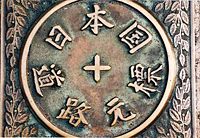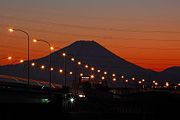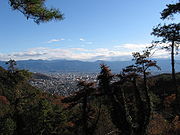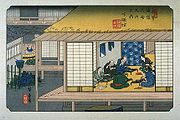
Koshu Kaido
Encyclopedia
The was one of the five routes
of the Edo period
and it was built to connect Edo
(modern-day Tokyo
) with Kai Province
in modern-day Yamanashi Prefecture
, Japan
. The route continues from there to connect with the Nakasendō
's Shimosuwa-shuku
in Nagano Prefecture
. Many feudal lords from Shinano Province
made use of the road during sankin kōtai
, including those from the Takatō Domain
, Suwa Domain
and Iida Domain.
The Kōshū Kaidō's route is followed closely by the modern Route 20
.




Edo Five Routes
The were the five major roads that started at Edo during the Edo period, the most important of which was the Tōkaidō, which linked Edo and Kyoto...
of the Edo period
Edo period
The , or , is a division of Japanese history which was ruled by the shoguns of the Tokugawa family, running from 1603 to 1868. The political entity of this period was the Tokugawa shogunate....
and it was built to connect Edo
Edo
, also romanized as Yedo or Yeddo, is the former name of the Japanese capital Tokyo, and was the seat of power for the Tokugawa shogunate which ruled Japan from 1603 to 1868...
(modern-day Tokyo
Tokyo
, ; officially , is one of the 47 prefectures of Japan. Tokyo is the capital of Japan, the center of the Greater Tokyo Area, and the largest metropolitan area of Japan. It is the seat of the Japanese government and the Imperial Palace, and the home of the Japanese Imperial Family...
) with Kai Province
Kai Province
, also known as , is an old province in Japan in the area of Yamanashi Prefecture. It lies in central Honshū, west of Tokyo, in a landlocked mountainous region that includes Mount Fuji along its border with Shizuoka Prefecture....
in modern-day Yamanashi Prefecture
Yamanashi Prefecture
is a prefecture of Japan located in the Chūbu region of the island of Honshū. The capital is the city of Kōfu.-Pre-history to the 14th century:People have been living in the Yamanashi area for about 30,000 years...
, Japan
Japan
Japan is an island nation in East Asia. Located in the Pacific Ocean, it lies to the east of the Sea of Japan, China, North Korea, South Korea and Russia, stretching from the Sea of Okhotsk in the north to the East China Sea and Taiwan in the south...
. The route continues from there to connect with the Nakasendō
Nakasendo
The , also called the , was one of the five routes of the Edo period, and one of the two that connected Edo to Kyoto in Japan. There were 69 stations between Edo and Kyoto, crossing through Musashi, Kōzuke, Shinano, Mino and Ōmi provinces...
's Shimosuwa-shuku
Shimosuwa-shuku
was the twenty-ninth of the sixty-nine stations of the Nakasendō, as well as being the ending location of the Kōshū Kaidō. It is located in the present-day town of Shimosuwa, Suwa District, Nagano Prefecture, Japan.-History:...
in Nagano Prefecture
Nagano Prefecture
is a prefecture of Japan located in the Chūbu region of the island of Honshū. The capital is the city of Nagano.- History :Nagano was formerly known as the province of Shinano...
. Many feudal lords from Shinano Province
Shinano Province
or is an old province of Japan that is now present day Nagano Prefecture.Shinano bordered on Echigo, Etchū, Hida, Kai, Kōzuke, Mikawa, Mino, Musashi, Suruga, and Tōtōmi Provinces...
made use of the road during sankin kōtai
Sankin kotai
was a policy of the shogunate during most of the Edo period of Japanese history. The purpose was to control the daimyo. In adopting the policy, the shogunate was continuing and refining similar policies of Toyotomi Hideyoshi. In 1635, a law required sankin kōtai, which was already an established...
, including those from the Takatō Domain
Takato Domain
The was a Japanese feudal domain of the Edo period, located in southern Shinano Province. Its capital was at Takatō Castle, in what is today the city of Ina, Nagano Prefecture.-History:...
, Suwa Domain
Suwa Domain
The was a Japanese feudal domain of the Edo period located in Shinano Province. Also called Takashima Domain , the domain was ruled from Takashima Castle, which is located in modern-day Suwa, Nagano Prefecture.-Hineno clan:...
and Iida Domain.
The Kōshū Kaidō's route is followed closely by the modern Route 20
Route 20 (Japan)
National Route 20 is a national highway connecting Tokyo and Shiojiri, Nagano prefecture in Japan. Originating at Nihonbashi in Chūō, Tokyo, it passes through Shinjuku and four other wards, and then seven cities, including Hachiōji in Tokyo. It follows a westward route into Kanagawa Prefecture,...
.
Stations of the Kōshū Kaidō
There are 44 post stations along the Kōshū Kaidō. They are listed below with they corresponding modern-day municipality listed in parentheses.Tokyo


- Starting Location: NihonbashiNihonbashi, or Nihombashi, is a business district of Chūō, Tokyo, Japan which grew up around the bridge of the same name which has linked two sides of the Nihonbashi River at this site since the 17th century. The first wooden bridge was completed in 1603, and the current bridge made of stone dates from 1911...
(ChūōChuo, Tokyois one of the 23 special wards that form the heart of Tokyo, Japan. The ward refers to itself as Chūō City in English.Its Japanese name literally means "Central Ward," and it is historically the main commercial center of Tokyo, although Shinjuku has risen to challenge it since the end of World War II...
) - 1. Naitō Shinjuku (内藤新宿) (ShinjukuShinjuku, Tokyois one of the 23 special wards of Tokyo, Japan. It is a major commercial and administrative center, housing the busiest train station in the world and the Tokyo Metropolitan Government Building, the administration center for the government of Tokyo.As of 2008, the ward has an estimated population...
) - 2. Shimotakaido-shuku (下高井戸宿) (SuginamiSuginami, Tokyois one of the 23 special wards of Tokyo, Japan. In English, it calls itself Suginami City.As of April 1, 2011, the ward has an estimated population of 538,703, with 301,277 households, and a density of 15,834.39 persons per km². The total area is 34.02 km².-Geography:Suginami occupies the...
) - 3. Kamitakaido-shuku (上高井戸宿) (Suginami)
- Fuda-Goshuku(布田五宿): Kokuryō-shuku,Shimofuda-shuku,Kamiishihara-shuku,Shimoishihara-shuku and Shimoishihara-shuku are all small posts.Because these five posts-tations united. This Union is said Fuda-Goshuku. Goshuku means five post-stations in Japanese.
- 4. Kokuryō-shuku (国領宿) (ChōfuChofu, Tokyois a city located in the western end of Tokyo Metropolis, Japan. As of 2010, the city has an estimated population of 224,878 and a population density of 10,440 persons per km². The total area was 21.53 km². Tokyo Stadium in Chōfu hosts soccer games for two J. League teams: F.C...
) - 5. Shimofuda-shuku (下布田宿) (Chōfu)
- 6. Kamifuda-shuku (上布田宿) (Chōfu)
- 7. Shimoishihara-shuku (下石原宿) (Chōfu)
- 8. Kamiishihara-shuku (上石原宿) (Chōfu)
- 4. Kokuryō-shuku (国領宿) (Chōfu
- 9. Fuchū-shuku (府中宿) (FuchūFuchu, Tokyois a city located in western Tokyo Metropolis, Japan. As of 2010, the city has an estimated population of 255,394 and a population density of 8,700 persons per km². The total area was 29.34 km²...
) - 10. Hino-shuku (日野宿) (HinoHino, Tokyois a city located in central Tokyo Metropolis, Japan. As of 2010, the city has an estimated population of 182,092 and a population density of 6,610 persons per km². The total area was 27.53 km².-Geography:...
) - 11. Hachiōji-shuku (八王子宿) (HachiōjiHachioji, Tokyois a city located in Tokyo, Japan, about 40 kilometers west of the center of the special wards of Tokyo.As of January 1, 2010, the city has an estimated population of 551,901 and a population density of 2,962.27/km². The total area is 186.31 km². It is the eighth largest city in the...
) - 12. Komagino-shuku (駒木野宿) (Hachiōji)
- 13. Kobotoke-shuku (小仏宿) (Hachiōji)
Kanagawa Prefecture
- 14. Ohara-shuku (小原宿) (SagamiharaSagamihara, Kanagawais a city located in north central Kanagawa Prefecture, bordering Tokyo, Japan. It is the third most populous city in the prefecture, after Yokohama and Kawasaki, and the fifth most populous suburb of Greater Tokyo. Its northern neighbor is Machida, with which a cross-prefectural merger has been...
) - 15. Yose-shuku (与瀬宿) (Sagamihara)
- 16. Yoshino-shuku (吉野宿) (Sagamihara)
- 17. Sekino-shuku (関野宿) (Sagamihara)
Yamanashi Prefecture

- 18. Uenohara-shuku (上野原宿) (Uenohara)
- 19. Tsurukawa-shuku (鶴川宿) (Uenohara)
- 20. Notajiri-shuku (野田尻宿) (Uenohara)
- 21. Inume-shuku (犬目宿) (Uenohara)
- 22. Shimotorisawa-shuku (下鳥沢宿) (ŌtsukiOtsuki, Yamanashiis a city located in Yamanashi, Japan. It was founded on August 8, 1954. As of 2008, the city has an estimated population of 29,803 and the density of 106 persons per km². The total area is 280.30 km².-Kōshū Kaidō:...
) - 23. Kamitorisawa-shuku (上鳥沢宿) (Ōtsuki)
- 24. Saruhashi-shuku (猿橋宿) (Ōtsuki)
- 25. Komahashi-shuku (駒橋宿) (Ōtsuki)
- 26. Ōtsuki-shuku (大月宿) (Ōtsuki)
- 27. Shimohanasaki-shuku (下花咲宿) (Ōtsuki)
- 28. Kamihanasaki-shuku (上花咲宿) (Ōtsuki)
- 29. Shimohatsukari-shuku (下初狩宿) (Ōtsuki)
- 30. Nakahatsukari-shuku (中初狩宿) (Ōtsuki)
- 31. Shirano-shuku (白野宿) (Ōtsuki)
- 32. Kuronoda-shuku (黒野田宿) (Ōtsuki)
- 33. Komakai-shuku (駒飼宿) (KōshūKoshu, Yamanashiis a city located in Yamanashi Prefecture, Japan.The city was founded on November 1, 2005, when the city of Enzan was merged with the town of Katsunuma, and the village of Yamato, both from Higashiyamanashi District, to form the new city of Kōshū....
) - 34. Tsuruse-shuku (鶴瀬宿) (Kōshū)
- 35. Katsunuma-shuku (勝沼宿) (Kōshū)
- 36. Kuribara-shuku (栗原宿) (YamanashiYamanashi, Yamanashiis a city located in Yamanashi Prefecture, Japan. In spite of the name, it is not the capital of the prefecture, which is Kofu.On June 1, 2011, the city had an estimated population of 37,927 with 14,453 households...
) - 37. Isawa-shuku (石和宿) (FuefukiFuefuki, Yamanashiis a city located in Yamanashi, Japan.The city was founded on October 12, 2004 from the merger of six towns and villages from Higashiyatsushiro and Higashiyamanashi Districts.The city abosorbed the village of Ashigawa on August 1, 2006...
) - 38. Kōfu-shuku (甲府宿) (KōfuKofu, Yamanashiis the capital city of Yamanashi Prefecture in Japan.As of May 1, 2011, the city had a estimate population of 197,540, with 85,794 households. The total area is 212.41 km².-History:Kōfu's name means "capital of Kai Province"...
) - 39. Nirasaki-shuku (韮崎宿) (NirasakiNirasaki, Yamanashiis a city in Yamanashi Prefecture, Japan.As of June 1, 2011, the city has an estimated population of 31,963, with 12,446 households and a population density of 222.38 persons per km². The total area is 143.73 km².The city was founded on October 10, 1954....
) - 40. Daigahara-shuku (台ヶ原宿) (HokutoHokuto, Yamanashiis a city located in Yamanashi, Japan.-Description:The city of Hokuto was founded by the merging of all the towns within the Kitakoma District except for the former town of Futaba, which merged with two municipalities to form the new city of Kai...
) - 41. Kyōraiishi-shuku (教来石宿) (Hokuto)
Nagano Prefecture

- 42. Tsutaki-shuku (蔦木宿) (FujimiFujimi, Naganois a town located in Suwa District, Nagano, Japan.As of 2003, the town has an estimated population of 15,525 and a density of 107.32 persons per km². The total area is 144.66 km².-External links:*...
, Suwa DistrictSuwa District, Naganois a district located in Nagano, Japan.As of 2003, the district has an estimated population of 46,162 and a density of 181.18 persons per km². The total area is 254.79 km².-Towns and villages:*Fujimi*Hara*Shimosuwa...
) - 43. Kanazawa-shuku (金沢宿) (ChinoChino, Naganois a city located in Nagano, Japan.As of 2003, the city has an estimated population of 55,902 and the density of 209.83 persons per km². The total area is 266.41 km².The city was founded on August 1, 1958.- Geography :*mountain**Mount Yatsugatake...
) - 44. Kamisuwa-shuku (上諏訪宿) (SuwaSuwa, Naganois a city located in Nagano, Japan.As of October 1, 2010, the city had an estimated population of 51,084 and a density of 468.40 persons per km². The total area of the city is 109.06 km²....
) - Ending Location: Shimosuwa-shukuShimosuwa-shukuwas the twenty-ninth of the sixty-nine stations of the Nakasendō, as well as being the ending location of the Kōshū Kaidō. It is located in the present-day town of Shimosuwa, Suwa District, Nagano Prefecture, Japan.-History:...
(ShimosuwaShimosuwa, Naganois a town located in Suwa District, Nagano, Japan. It is located on Lake Suwa, a large, natural lake surrounded by mountains.As of 2006, the town has an estimated population of 22,421. The total area is 66.90 km²....
, Suwa District) (also part of the NakasendōNakasendoThe , also called the , was one of the five routes of the Edo period, and one of the two that connected Edo to Kyoto in Japan. There were 69 stations between Edo and Kyoto, crossing through Musashi, Kōzuke, Shinano, Mino and Ōmi provinces...
)
See also
- Edo Five RoutesEdo Five RoutesThe were the five major roads that started at Edo during the Edo period, the most important of which was the Tōkaidō, which linked Edo and Kyoto...
- TōkaidōTokaido (road)The ' was the most important of the Five Routes of the Edo period, connecting Edo to Kyoto in Japan. Unlike the inland and less heavily travelled Nakasendō, the Tōkaidō travelled along the sea coast of eastern Honshū, hence the route's name....
(or 53 Stations of the Tōkaidō53 Stations of the TokaidoThe are the rest areas along the Tōkaidō, which was a coastal route that ran from Nihonbashi in Edo to Sanjō Ōhashi in Kyoto.-Stations of the Tōkaidō:...
) - NakasendōNakasendoThe , also called the , was one of the five routes of the Edo period, and one of the two that connected Edo to Kyoto in Japan. There were 69 stations between Edo and Kyoto, crossing through Musashi, Kōzuke, Shinano, Mino and Ōmi provinces...
(or 69 Stations of the Nakasendō69 Stations of the NakasendoThe are the rest areas along the Nakasendō, which ran from Nihonbashi in Edo to Sanjō Ōhashi in Kyoto. The route stretched approximately and was an alternate trade route to the Tōkaidō.-Stations of the Nakasendō:...
) - Ōshū KaidōOshu KaidoThe was one of the five routes of the Edo period and it was built to connect Edo with Mutsu Province and the present-day city of Shirakawa, Fukushima Prefecture, Japan...
- Nikkō KaidōNikko KaidoThe was one of the five routes of the Edo period and it was built to connect Edo with the Nikkō Tōshō-gū, which is located in the present-day city of Nikkō, Tochigi Prefecture, Japan. It was established in 1617 by Tokugawa Ieyasu, in order for him to have a smoother route to the shrine...
- Tōkaidō

